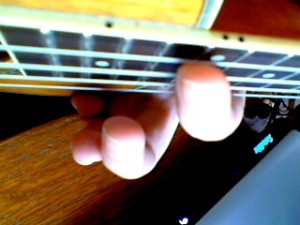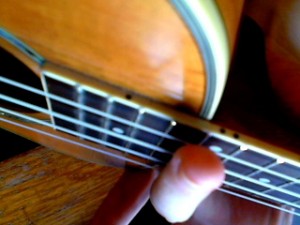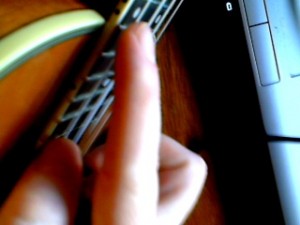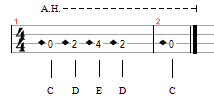Harmonics are a big part of Hawaiian lap steel playing where they’re referred to as ‘chimes’ because of their bright ping sound (hence tunes such as Maui Chimes). Unfortunately, because of the short scale length, they’re much harder to produce on the ukulele.
Natural Harmonics
You produce a harmonic by touching the string only very lightly. So that if you moved your finger a tiny amount, you wouldn’t be touching the string at all. Like this:
The easiest place to play a harmonic is at the 12th fret. You have to position your finger directly over the fret bar itself rather than between the frets as you’d usually do. Pluck that harmonic and listen to what you hear. If you’ve got everything right, you should hear a bright ping that rings out and it should have the pitch of the string played at the 12th fret. If you hear a dull click, you’re pressing down too hard. If you hear just an open string, you’re not touching the string. If you hear something out of tune that dies away quickly, you’re not directly over the fret.
Playing all the strings in succession should sound like this:
You can also play this by barring across at the 12th fret and touching the string with the side of your finger.
As well as playing harmonics at the 12th, they can also be found at the seventh fret (where they sound 19 frets higher than the open string).
And at the fifth fret (where they’re 24 frets/2 octaves higher than the open string).
As you can tell from my rather dodgy attempt, these harmonics are very hard to get right on the uke.
Harmonics in Tab
Natural harmonics are tabbed by having a little diamond next to the fret number.
Artificial Harmonics
I know what you’re thinking, “Easy peasy, lemon squeezey. Give me a challenge.” Fair enough.
With artificial harmonics you fret a note as usual and play a harmonic. To do this, you have to produce a harmonic by pointing with your index finger and picking the note.
I like to pick with my ring finger, but the middle finger or thumb work just as well.
You fret the note and play the harmonic 12 frets above it (or 5 or 7).
In this sequence I play the open C string with the harmonic at the 12th fret. Then fret at the 2nd fret and play the harmonic at the 14th fret. Then finger the fourth fret and play the harmonic at the sixteenth.
Artificial harmonics are tabbed by showing the fret played and the note produced underneath the tab. All these are have harmonics 12 frets higher than the fretted notes.
You can use this build up entire chords with harmonics.
Again, with all these you play the harmonic 12 frets higher than the fretted note.
Once you’ve got the hang of all these and have a load of time on your hands, you can work out how to play tunes using harmonics. Here’s my attempt:
And if you want tab for that, you’ll have to wait until Christmas.









Thanks a lot Al! You answered all my questions about harmonics in the first five sentences, then raised some more questions and answered those as well. Good stuff.